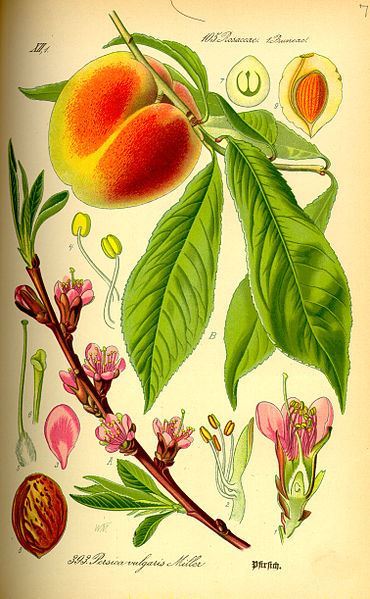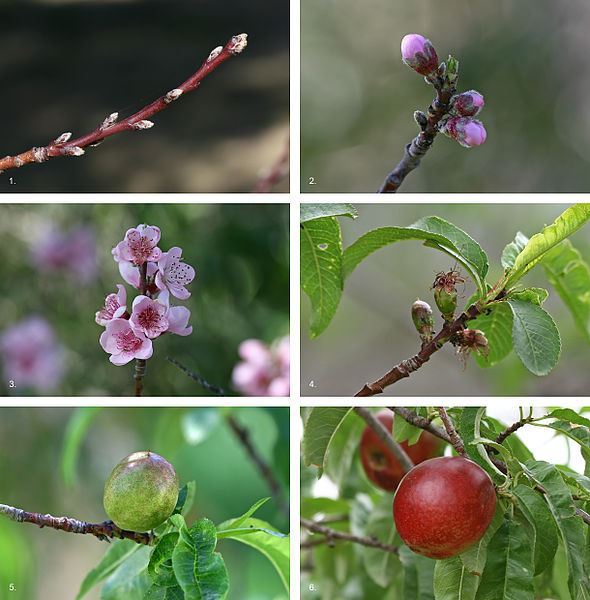Reposted from February 4, 2016

Peach flower, fruit, seed and leaves as illustrated by Otto Wilhelm Thomé (1885) public domain via Wikimedia Commons.
Peaches and nectarines are the same fruit minus a small genetic variation that makes nectarines hairless. When I first learned this little trivia tidbit I wondered about the difference in flavour. I prefer nectarines to peaches, but wondered if the taste difference was all in my head. Well, it’s not.
The genetic variation affects flavour, aroma, size, shape and texture. While the rough location of the genetic change has been known for some time, the exact gene and the exact change in the DNA sequence of “nectarineness” has been a mystery. In March, scientists from Italy finally identified a disruption in a “fuzz” gene that is absent in peaches.
Agriculturists in China gifted fruit lovers with the peach about 4000 to 5000 years ago. At least 2000 years ago, again in China, nectarines burst on to the scene. Charles Darwin pondered about how nectarines popped up on peach trees and vice versa and described the odd finding of one fruit that was half and half. Would we call that a “peacharine?”
Darwin, and others, deduced that the nectarine was a peach variety. In 1933, scientists determined a recessive gene variant was responsible for the inheritance pattern of the nectarine's hairless (glabrous) skin. The glabrous trait was given the designation G, with big G for the normal fuzzy peach character and little g for the glabrous nectarine character. Each fruit has two copies of this gene. Each parent gives one to the offspring fruit, which can be either GG, Gg, or gg, and only the gg fruits are nectarines.
The chromosomal location of the G trait was already roughly landmarked but the Italian research team zoomed in on the spot, sort of like how you zoom in to street view with Google maps. Many DNA sequence differences exist between nectarines and peaches that are not located in genes but are useful as landmarks along the chromosomes. These are called genetic markers. To zoom in on the G trait, the researchers crossed peach and nectarine trees and followed the offspring through two generations. The offspring had a mixture of peach and nectarine markers along their chromosomes but certain genetic markers, the ones closest to the G trait location, always went along with the nectarineness. These genetic markers landmarked the region to search for genes with mutations that could explain a nectarine’s fuzz-less-ness.

Nectarine Fruit Development by jjron - Own work. Licensed under CC BY-SA 3.0 via Wikimedia Commons.
Within the landmarked region, the researchers identified a disrupted gene. The peach to nectarine gene disruption is a genetic modification by the hand of Mother Nature, an insertion of a transposable element. This type of DNA element can move because it contains its own code for the production of an enzyme that can “cut”and “paste” the transposable element to other locations in the genome. Transposable elements can get pasted right in the middle of genes, disrupting the DNA sequence. They are a known cause of genetic variation in plants. If you like chardonnay wine, you can thank a transposable element for disrupting the cabernet grape genome long ago.
In nectarines the transposable element stuck itself right in the middle of a gene called PpeMYB25. Genes with similarities to PpeMYB25 in other plants are important for making plant hair, called trichome, which can occur on the stem, leaves, flowers and fruit of plants. The PpeMYB25 gene is the recipe for making a protein that is a transcription factor, a type of protein that controls when and how much other genes are turned on, so a mutation in this one gene could explain not just baldness in nectarines but other nectarine characteristics as well, depending on what these other genes are that it controls. In this report the researchers focused on the peach fuzz characteristic. When they looked at flower buds during the period when fuzz or trichome first develops, they found PpeMYB25 to be active in the peach but not the nectarine buds.
This is the first description of a specific genetic modification that can explain the difference between peaches and nectarines, something that has long been a mystery.
This research makes a strong case that nectarine lack of fuzz is due to the inability of nectarines to produce the PpeMYB25 protein. How lack of PpeMYB25might lead to the other nectarine characteristics — flavour, for instance — still needs to be worked out.
References:
Vendramin, E. et al. (2014) A Unique Mutation in a MYB Gene Cosegregates with the Nectarine Phenotype in Peach. PLOS ONE. 9: e90574
Ien-Chi, W. et al. (1995) Comparing Fruit and Tree Characteristics of Two Peaches and Their Nectarine Mutants. J. Amer. Soc. Hort. Sci. 120(1):101-106. </a>
Darwin, C. (1868) The Variation of Animals and Plants Under Domestication, Volume 1, pg 363.
By Meredith Hanel
Meredith is a science writer who once enjoyed life in the lab as a biomedical researcher. She blogs at BiologyBizarre and tweets @MeredithHanel
